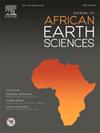Anomaly separation of gravity data using filtering techniques: Case study of the Ziway and Koka sub basins, central main Ethiopian rift, Ethiopia
IF 2.2
4区 地球科学
Q2 GEOSCIENCES, MULTIDISCIPLINARY
引用次数: 0
Abstract
This study applies three filtering techniques: frequency, upward continuation (UC), and trend surface polynomial filters, to the ground and satellite gravity data from the Ziway–Koka sub-basins to separate the regional and residual anomaly components of the complete Bougour anomaly (CBA). The estimated regional anomalies are then evaluated to identify the relatively reliable filtering technique for the study area. For the UC filter, regional anomaly grids were evaluated using successive UC to heights ranging from 0.5 to 5 km to determine the optimum height for estimating the regional anomalies. Consequently, a UC height of 5 km was determined to best represent the regional anomaly with enhanced resolution. Radial average power spectrum curves were used to determine the cut-off frequency applied in compiling the regional anomaly grid map. As a result, a cut-off frequency of 0.0970525097 cycles/km was applied to the ground-based gravity data, and 0.0918813153 cycles/km to the satellite-based data for estimating the regional anomaly component. Moreover, first, second, and third-order polynomial filters were applied to estimate the regional anomaly component to determine which order offers the best resolution. Among these, the first-order polynomial filter provides a smooth and linear representation of the regional field and was therefore selected as suitable for estimating the regional anomaly with improved resolution. The residual anomaly grids obtained from each filter are quantitatively compared by correlating the anomalies extracted along the profile AA with their corresponding analytical signal anomaly values determined from the CBA grids. For the ground-based gravity data, the correlation coefficients for the frequency, UC, and first-order polynomial filters are 0.64, 0.89, and 0.79, respectively, while for the satellite-based data, the corresponding values are 0.60, 0.86, and 0.84. These results indicate that the UC filter is relatively more reliable for estimating the regional anomaly as compared to the other filters and also effective in decomposing the CBA into its regional and residual components.
利用滤波技术分离重力数据的异常:以埃塞俄比亚中部主裂谷Ziway和Koka子盆地为例
本文采用频率滤波、向上延延滤波和趋势面多项式滤波三种滤波技术,对来自Ziway-Koka子盆地的地面和卫星重力数据进行滤波,分离出完整Bougour异常(CBA)的区域和残余异常分量。然后对估计的区域异常进行评估,以确定研究区域相对可靠的滤波技术。对于UC滤波器,使用连续的UC到0.5至5 km的高度来评估区域异常网格,以确定估计区域异常的最佳高度。因此,确定了5 km的UC高度最能代表区域异常,并提高了分辨率。采用径向平均功率谱曲线确定截止频率,用于编制区域异常网格图。结果表明,利用0.0970525097 cycles/km和0.0918813153 cycles/km分别对地面重力数据和卫星重力数据进行区域异常分量估算。此外,采用一阶、二阶和三阶多项式滤波器来估计区域异常分量,以确定哪种阶能提供最佳的分辨率。其中,一阶多项式滤波器对区域场具有平滑和线性的表征,因此被认为适合用于区域异常的估计,并提高了分辨率。通过将沿AA剖面提取的异常与CBA网格确定的相应分析信号异常值相关联,定量比较各滤波器获得的剩余异常网格。对于地面重力数据,频率、UC和一阶多项式滤波器的相关系数分别为0.64、0.89和0.79,而卫星数据的相关系数分别为0.60、0.86和0.84。这些结果表明,UC滤波器相对于其他滤波器在估计区域异常方面更可靠,并且在将CBA分解为区域分量和残差分量方面也更有效。
本文章由计算机程序翻译,如有差异,请以英文原文为准。
求助全文
约1分钟内获得全文
求助全文
来源期刊

Journal of African Earth Sciences
地学-地球科学综合
CiteScore
4.70
自引率
4.30%
发文量
240
审稿时长
12 months
期刊介绍:
The Journal of African Earth Sciences sees itself as the prime geological journal for all aspects of the Earth Sciences about the African plate. Papers dealing with peripheral areas are welcome if they demonstrate a tight link with Africa.
The Journal publishes high quality, peer-reviewed scientific papers. It is devoted primarily to research papers but short communications relating to new developments of broad interest, reviews and book reviews will also be considered. Papers must have international appeal and should present work of more regional than local significance and dealing with well identified and justified scientific questions. Specialised technical papers, analytical or exploration reports must be avoided. Papers on applied geology should preferably be linked to such core disciplines and must be addressed to a more general geoscientific audience.
 求助内容:
求助内容: 应助结果提醒方式:
应助结果提醒方式:


